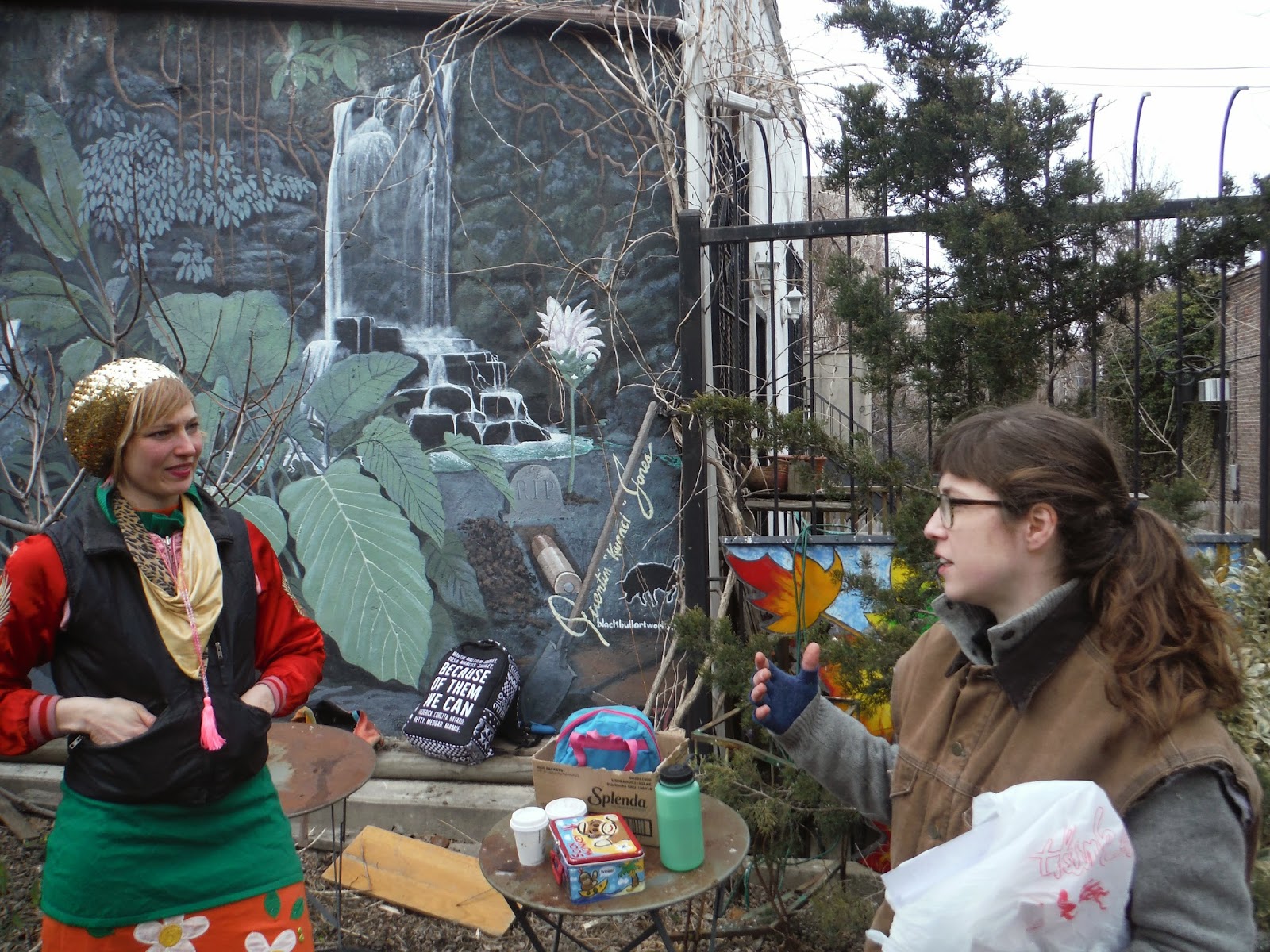 |
| The first time I ever heard about Roger That Garden, we were at a press conference at City Hall and a couple of activists from the garden were holding a space suit, their mascot for their garden, calling for the city to protect the gardens. |
 |
| Roger That Community Garden |
Saturday I visited Elizabeth Street Garden to put in some
time hosting. It’s a majestic
sculpture garden just north of Little Italy. It might as well be Rome. In
the middle of Manhattan, cats crawl around along with sun bathers enjoying this
space to just be alive.
Several volunteers were there. We talked about the history of the space and the current campaign to keep it open.
Several volunteers were there. We talked about the history of the space and the current campaign to keep it open.
“Do you think we’ll win,” I asked one volunteer, busy
reminding visitors to sign petitions and letters to the Mayor not to bulldoze
the garden.
“I don’t think the Mayor wants more bad press after what
happened at that nursing home,” she explained.
Its been a rough week for gardens. Roger
That, a majestic garden in Brooklyn, lost its battle. Its being closed down.
"Not always winning," their lawyer, Paula Z. Segal, posted on facebook on May 25.
DNA info reported:
"Not always winning," their lawyer, Paula Z. Segal, posted on facebook on May 25.
DNA info reported:
“A realty company has
closed the Roger That community garden in Crown Heights this week following a ruling earlier this
spring that granted the owners permission to evict the group, gardeners and
their attorney said.”
A year ago, Public Space Party visited Roger That during our Gardens in Danger Ride. with 596 Acres.
As the time, I wrote:
"Grown from a crumbling building, this is a community space in Crown Heights, Brooklyn that stewards native plants, grows edibles, and maintains community compost. Roger That garden is currently under threat of development by a real estate developer who purchased the deed to the land, subject to hundreds of thousands of dollars in tax debt liens, for $10 from the man who used to own and operate a hardware store on this lot before abandoning the buildings. The developers have attempted to illegally evict the garden through a lock-out. It had been an abandoned space, but now someone wants to make money with it. But we want to preserve it, noted Vigil. We want to save it, preserve it and have it secured. The paper for the property needs to move to a land trust of the Parks department.
A year ago, Public Space Party visited Roger That during our Gardens in Danger Ride. with 596 Acres.
As the time, I wrote:
"Grown from a crumbling building, this is a community space in Crown Heights, Brooklyn that stewards native plants, grows edibles, and maintains community compost. Roger That garden is currently under threat of development by a real estate developer who purchased the deed to the land, subject to hundreds of thousands of dollars in tax debt liens, for $10 from the man who used to own and operate a hardware store on this lot before abandoning the buildings. The developers have attempted to illegally evict the garden through a lock-out. It had been an abandoned space, but now someone wants to make money with it. But we want to preserve it, noted Vigil. We want to save it, preserve it and have it secured. The paper for the property needs to move to a land trust of the Parks department.
Roger That can be saved if the City invokes eminent domain and buys the property to preserve it as a Parks Department garden. Eminent domain has been used to create New York’s parks and open spaces dating at least back to 1807. Prospect Park, Central Park, the Ocean Parkway Greenway and Astor place are just a few of the over 350 condemnations for the creation or preservation of parks and open spaces that have been recorded in New York’s county courts."
We visited the garden several times last spring, including on the Cyclista Ride #5.
Emily, who I'd met at the garden press conference at City Hall Park, welcomed us to the garden, putting on a gardening workshop for some local girl scouts, teaching them about their garden.
“Welcome to Roger That Garden,” she explained, telling us about her garden. “Our garden is under threat. So we need you to call Roger Corgney and ask that the garden be saved.”
Roger that has a petition everyone can sign as well as steps one can take to save the garden. The current owner has been missing in action from the lot since the early 1980’s. The Department of Finance for the City has no info on the owner, yet apparently the space has been sold. “They got the garden for no money," noted Emily. "How did they get the deed? There is something fishy going on here. Call Roger Corgney and Tish James. Tell them this garden is important to all of us.”
Roger that has a petition everyone can sign as well as steps one can take to save the garden. The current owner has been missing in action from the lot since the early 1980’s. The Department of Finance for the City has no info on the owner, yet apparently the space has been sold. “They got the garden for no money," noted Emily. "How did they get the deed? There is something fishy going on here. Call Roger Corgney and Tish James. Tell them this garden is important to all of us.”
In 2006, this was a derelict space, attached a crumbling building at the corner that eventually came down. The Crown Heights Youth Collective, who had been supporting cleaning other lots, cleaned this space. A vibrant community mural was posted on a building remaining. The group named the space and started organizing the garden there in 2011.
Emily joined the garden after all others she wanted to join were full or had waiting lists for plots. “We started this space to be communal,” she explained. They wanted the space to be open for all people and living creatures in the neighborhood. “We have nice tulips and other native plants here. 75% of the plants here are native.”
She pointed at the raised beds and perennials and the birds flying nearby.
Standing by our sign declaring: “Gardens are the Future of Cities,” we asked Emily why this garden was so important for NYC.
 |
| Gardens are the future of cities at Roger That. Photo by Monica. |
“This is a learning space,” she explained, gesturing to the kids working there. “It is a space for food pollinators. We retain rain water. We help kids learn about science and the environment. It is a safe place to hang out. We are preventing flooding and training science educators. If we do not have real places to interact and hang out, its just going to be shopping malls here. We need real open space here.”
The Crown Heights Girl Scouts had a message for the City. Save the Garden.
The Crown Heights Girl Scouts had a message for the City. Save the Garden.
A year later, efforts to save the garden through eminent domain have not found support. Instead, the city seems to have turned itself over to real estate developers as its moved to create more housing.
But gardeners know, the city needs both housing and gardens, not one or the other.
But gardeners know, the city needs both housing and gardens, not one or the other.
Sadly, far too many of the precious little bits of soul the city are lost in the fury. One step up, two steps back, some gardens are becoming park spaces; others are disappearing.
Hopefully, Elizabeth Street Garden does not meet the same fate as Roger That. This is a space that is open to the community, offering a little beauty and solace for everyone in this rough and often lonely city.
So, lets save it and the city.
As a member of our community, we urgently need your help and your voice.
Write Mayor de Blasio and tell him that you oppose the City’s looming plan to issue a Request For Proposal to developers to build affordable housing that would destroy Elizabeth Street Garden!
We need to act now to dissuade the NYC Department of Housing Preservation & Development, as this could happen imminently.
How You Can Help:
So, lets save it and the city.
Act Now to Save Our Garden Write Mayor de Blasio Today!
Dear Neighbors and Friends,As a member of our community, we urgently need your help and your voice.
Write Mayor de Blasio and tell him that you oppose the City’s looming plan to issue a Request For Proposal to developers to build affordable housing that would destroy Elizabeth Street Garden!
We need to act now to dissuade the NYC Department of Housing Preservation & Development, as this could happen imminently.
How You Can Help:
- Write the mayor and forward this action to your neighbors and friends asking them to write a letter too.
- Share this tweet and Facebook post.
- Join the discussion on social media. Use #elizabethstreetgarden and #ESGSaveOurGarden.
Thanks to the hundreds of supporters who have already sent letters to the mayor!
The City can save all the community gardens if it wants to.
As 596 Acres Points out:

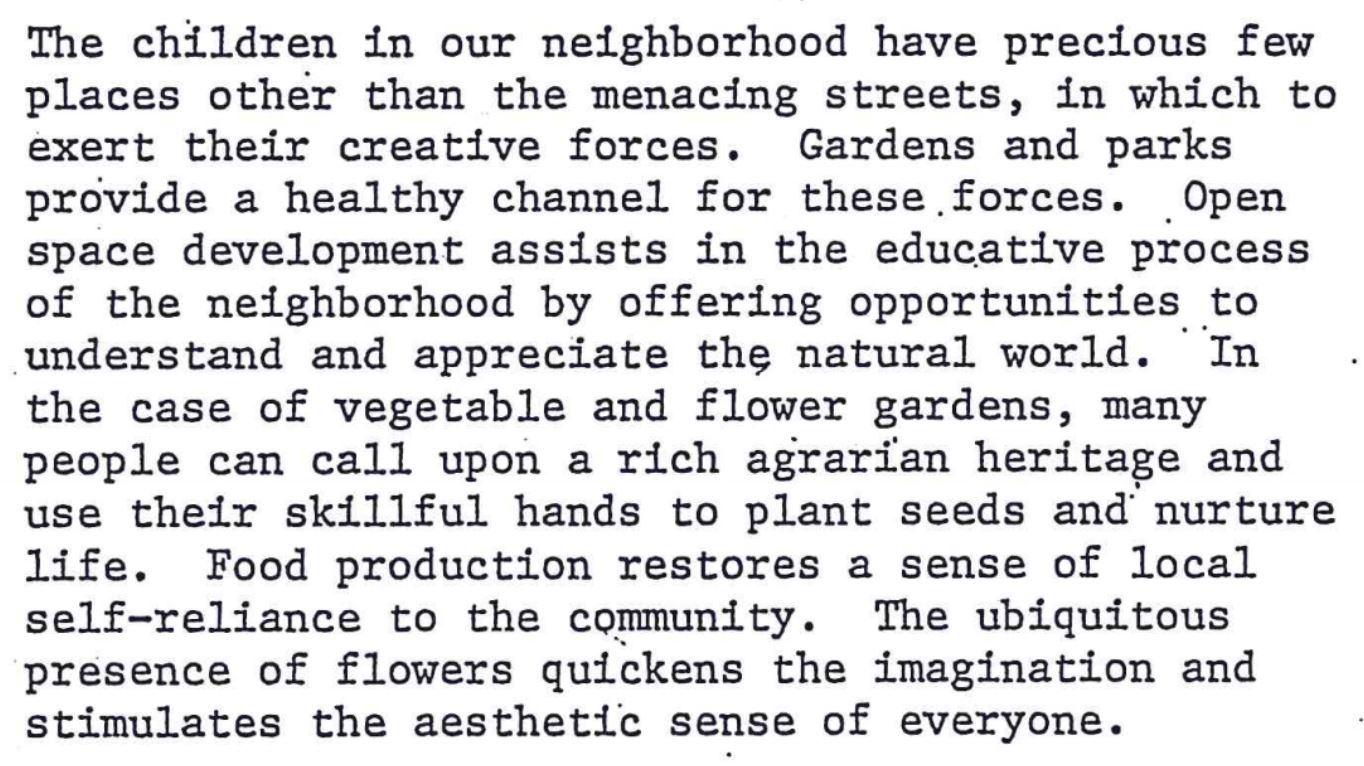
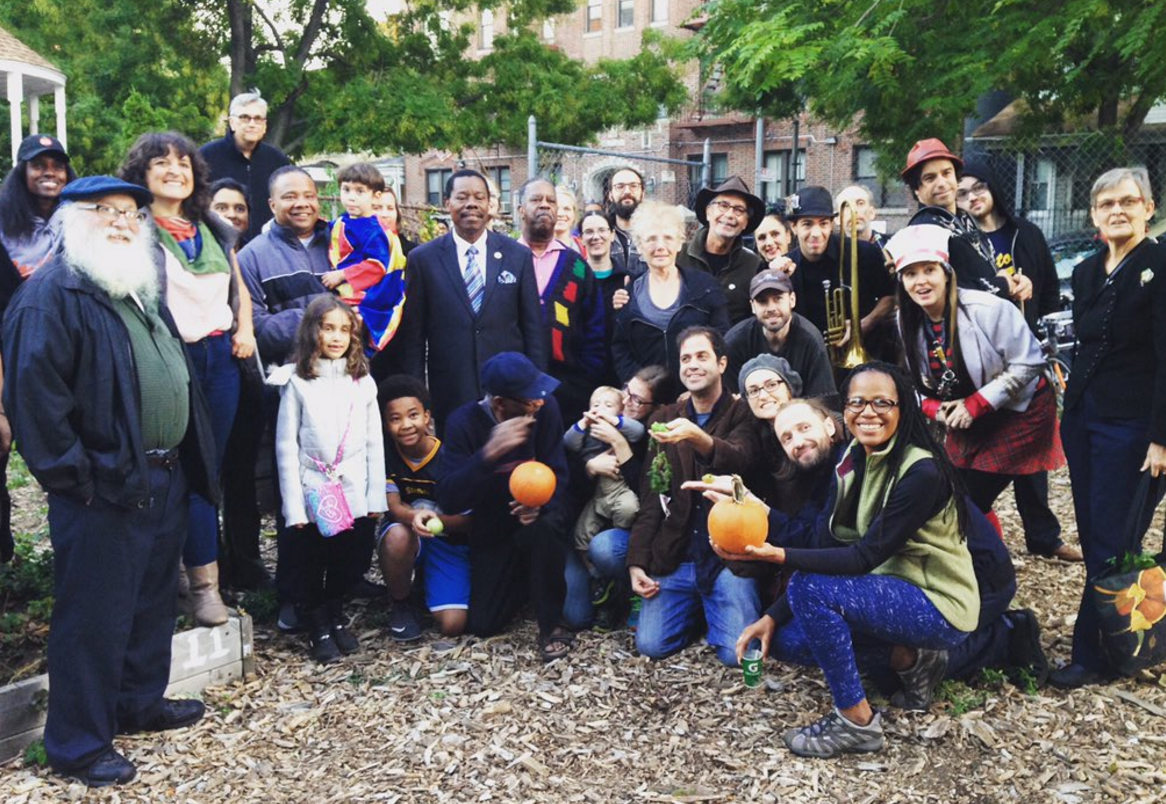
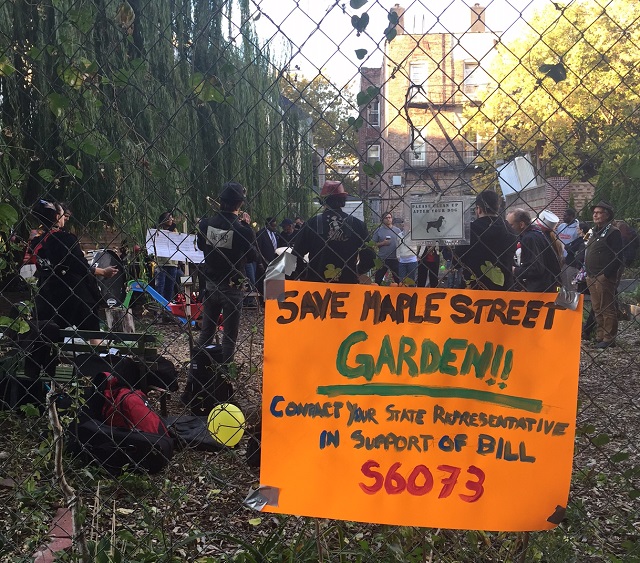
Maple Street Community Gardeners organize in Fall 2015. Photos by Paula Z. Segal (R) and courtesy CUNY Law School/Public Square Magazine (L).
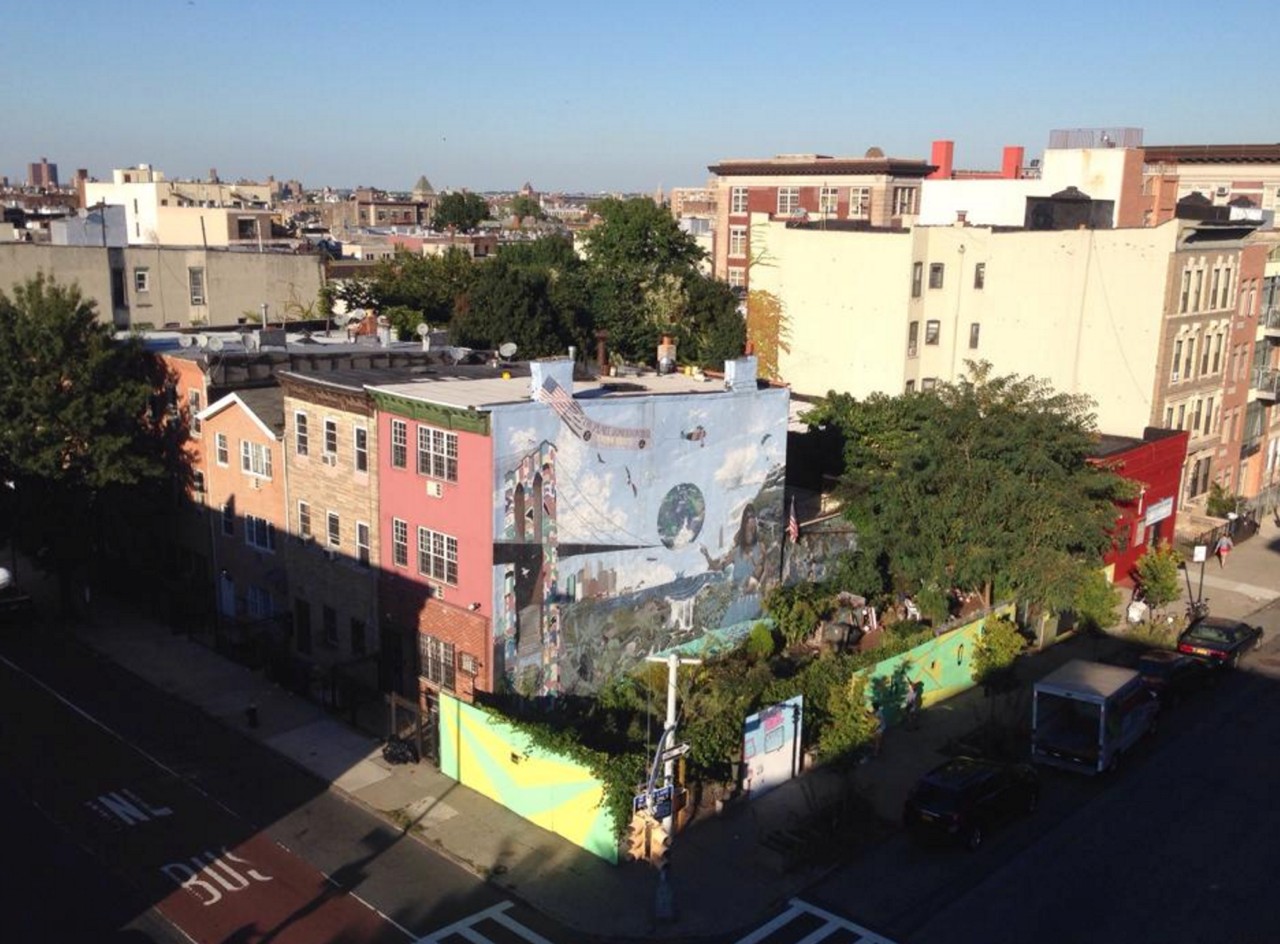
Roger That garden, Summer 2015. Photo courtesy Roger That! Garden.
As 596 Acres Points out:
Release: Communities Propose Eminent Domain to Save Gardens Threatened by Private Development
May 19, 2016
NEW YORK, NY - It’s time we ask ourselves: “How can we have eminent domain for the Barclays Center and not have eminent domain for the constituents of the community?”
This Sunday, March 22 from 3 to 7pm, 596 Acres will present a pop-up exhibition on #eminentdomain4good at El Jardin del Paraiso, a sprawling Parks Department community garden in the Lower East Side at 5th Street between Ave. C & D in Manhattan.
Photographs from the garden’s founding and an audio documentary made last year by 596 Acres for What Do We Do With Our Land? for the New Museum's IDEAS CITY Festival, in collaboration with founding gardeners, will be on display. Stories from other gardens in New York City that are perfectly suited to become new Parks, including Imani I Community Garden in Weeksville, Maple Street Community Garden in Prospect Lefferts and Roger That! Garden in Crown Heights, will also be shared, along with opportunities to support gardeners’ campaigns to preserve them through #eminentdomain4good.
Since at least 1807, eminent domain has been used to create New York’s parks and open spaces. El Jardin del Paraiso is among Prospect Park, Central Park, Astor Place and over 350 other condemnations for the creation or preservation of parks and open spaces that have been recorded in New York’s county courts. As El Jardin del Paraiso’s story shows, eminent domain can facilitate the preservation of value that residents create by transforming vacant lots into community spaces.
L: Making Paraiso, roughly 1981. Courtesy of Howard Brandstein. R: An excerpt from Lower East Side Gardeners’ proposal to preserve open space, presented to Community Board 3 in 1982. Lower East Side Gardeners served a constituency of over 200 people from different Lower East Side gardens. Courtesy of Howard Brandstein.
El Jardin del Paraiso, a meadow-like green space in the dense Loisaida (Alphabet City), was created by local residents in 1981 out of series of empty lots, some owned by the City and some owned by private entities. Homesteaders, gardeners, artists, religious leaders, the Junior League, and the principal of P.S. 15, worked together to advocate for the expansion and preservation of the garden as a permanent park. The group convinced the City that El Jardin was perfectly situated to become a new park for the Lower East Side in a part of the neighborhood badly served by the existing green spaces. During the 1990s, the City condemned three lots that it did not then own that divided the space using eminent domain, making the park whole.
Imani I Community Garden in Weeksville, Brooklyn has similar beginnings: neighbors got together to provide themselves with the services they needed – in this case, with open green space and fresh food – in a neighborhood full of holes. Now, over 40 years since its founding, eminent domain may be the only way to save this garden from being permanently ravaged by the City’s illegal sale of tax debt, that should have never been owed in the first place, to private speculators. It's a tough one to explain to the generations of gardeners who have been caring for the space for decades since it was created by Parishioners of Our Lady of Charity, the first black Catholic congregation in the diocese, in 1974. To keep the garden whole, the City or State government can buy the property from the private owner and turn it over to the NYC Parks Department GreenThumb program for continued management by volunteers.
Maple Street Community Gardeners organize in Fall 2015. Photos by Paula Z. Segal (R) and courtesy CUNY Law School/Public Square Magazine (L).
Maple Street Community Garden, in Brooklyn’s Prospect-Lefferts Gardens, has recently become a poster-child for the kind of trickery and fraud that accompanies real estate booms. The story of its creation is familiar: neighbors got fed up with the vacant lot on their block and, with no accountable owner in site, they began to clear out the impressive garbage that had collected in the summer of 2013. They built raised beds and planted flowers and vegetables. In 2015, State Senator Jesse Hamilton and Assembly Member Diana Richardson introduced bills in the NYS Senate and in the Assembly to preserve the Maple Street Community Garden through eminent domain. The exhibition will provide an opportunity for attendees to support the bills and to petition the Mayor, City Council and NYC Parks directly.
Roger That garden, Summer 2015. Photo courtesy Roger That! Garden.
Roger That! Garden in Crown Heights, Brooklyn, is another garden in jeopardy that can be preserved through #eminentdomain4good. Assembly Member Richardson and Senator Velmanette Montgomery have also introduced bills aimed at protecting the Roger That! Garden as parkland.
At the event this Sunday, visitors will listen to the histories, see the photos, send letters, and find out more about 596 Acres’ community land access advocacy program. This exhibition is part of El Jardin del Paraiso’s Mudball Ball. If we can use eminent domain for El Jardin del Paraiso under Mayor Rudy Giuliani, we can certainly continue to use it for the little bits of green paradise that neighbors have created in their neighborhoods in Brooklyn today.
Brooklyn is a majestic space. Its public spaces need to expand not contract.
Brooklyn is a majestic space. Its public spaces need to expand not contract.
 |
| New York's publics shimmer. We should protect them, not give them away one by one. |




























